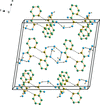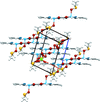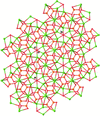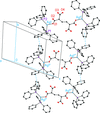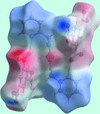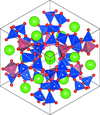issue contents
February 2016 issue

Cover illustration: Two new polymorphs of the simple compound 2,4,6-tribromobenzonitrile, C7H2Br3N, C7H2Br3N, C7H2Br3N (RCN), are described, as well as a redetermination of the known polymorph to modern standards. In each structure, the molecules associate into layers via short C![[triple bond]](/logos/entities/z-tbnd_rmgif.gif) N
N Br contacts, but differ in their layer-stacking sequence. The re-determined structure of the isomeric 1,3,5-tribromo-2-isocyanobenzene (RNC) is isostructural with one of the new polymorphs of RCN. See: Britton, Noland & Tritch [Acta Cryst. (2016). E72, 178-183].
Br contacts, but differ in their layer-stacking sequence. The re-determined structure of the isomeric 1,3,5-tribromo-2-isocyanobenzene (RNC) is isostructural with one of the new polymorphs of RCN. See: Britton, Noland & Tritch [Acta Cryst. (2016). E72, 178-183].
research communications
Download citation


Download citation


The UVI atom exhibits a pentagonal–bipyramidal N2O5 coordination environment. In the complex, the 1,2,4-triazole ligand is coordinated in a tridentate manner.
CCDC reference: 1443165
Download citation


Download citation


In the title rhenium(I) tricarbonyl complex with triphenylarsane and deprotonated quinaldic acid ligands, the ReI atom is in an octahedral coordination. Weak C—H⋯O interactions lead to a three-dimensional supramolecular architecture.
CCDC reference: 1443806
Download citation


Download citation


In C6H6N2O2·H2O, the N-hydroxypicolinamide molecule adopts a strongly flattened conformation. O—H⋯O interactions and π–π stacking interactions between the pyridine rings organize the crystal components into columns extending along the b axis while N—H⋯N hydrogen bonds link these columns into a two-dimensional framework parallel to (100).
CCDC reference: 1444026
Download citation


Download citation


The reported homonuclear Pd4 cluster is presented in relation to structural analogues. Gradual evaporation of the trapped solvent molecules results in a unilateral contraction of the unit cell, transforming it into the solvent-free structure.
CCDC reference: 1443364
Download citation


Download citation


The crystal structure of the title novel organic–inorganic supramolecular salt is based in the in situ formation of 4,4′-methylenebis(3,5-dimethyl-1H-pyrazol-2-ium) cations, which are engaged in N—H⋯O hydrogen bonds with β-octamolybdate anions.
CCDC reference: 1443502
Download citation


Download citation


In the title free base porphyrin, the neighbouring N⋯N distances in the center of the ring vary from 2.818 (8) to 2.998 (8) Å and the phenyl rings are tilted from the 24-atom mean plane at angles varying between 62.42 (2) to 71.63 (2)°. The free base porphyrin is characterized by a significant degree of ruffled (B1u) distortion with contributions from domed (A2u) and wave [Eg(y) and Eg(x)] modes.
CCDC reference: 1444998
Download citation


Download citation


In the title compound, the mean planes of the pyrrole and benzyl rings are almost normal to one another with a dihedral angle of 87.07 (4)°. In the crystal, molecules are linked via a pair of N—H⋯O hydrogen bonds forming inversion dimers. C—H⋯O hydrogen bonds link the dimers into chains propagating along [10 ].
].
CCDC reference: 1445256
Download citation


Download citation


This known quorum-sensing modulator exhibits signs of an intramolecular attractive carbonyl–carbonyl n→π* interaction between the amide and lactone ester groups. Moreover,a similar n→π* interaction is observed for the amide carbonyl group approached by the ketone oxygen donor. These interactions apparently affect the conformation of the uncomplexed molecule, which adopts a different shape when bound to protein receptors.
CCDC reference: 1444720
Download citation


Download citation


The N9—H protonated and N7—H tautomeric form of N6-benzoyladenine cations are bridged by one of the oxygen atoms of the nitrate anion via N—H⋯O hydrogen bonds, generating a ribbon motif. The cations also form base pairs via N—H⋯O and C—H⋯N hydrogen bonds.
CCDC reference: 1444600
Download citation


Download citation


The title compound, Sr2CdPt2, adopts the Ca2GaCu2 structure type and exhibits linear platinum chains with two different Pt—Pt bonds of 2.7341 (13) and 3.2010 (14) Å.
CCDC reference: 1444811
Download citation


Download citation


In this article we report a synthetic procedure and structure of the novel dinuclear copper(II) complex, with a bridging oxalodihydroxamate ligand and terminal 2,2′-bipyridine and DMSO ligands completing the square pyramidal coordination spheres of the Cu(II) centres..
CCDC reference: 1445115
Download citation


Download citation


The central structural motif of the title coordination polymer, [Co(C4H4N2)(CH3CN)2(H2O)2(NO3)2]n, is a chain composed of CoII ions linked by bis-monodentate bridging pyrazine ligands through their N atoms. Nitrate anions are situated in the space between the CoII chains
CCDC reference: 1445438
Download citation


Download citation


The thiazole ring of the title compound is twisted with respect to the three benzene rings, making dihedral angles of 25.52 (12), 85.77 (12) and 81.85 (13)°.
CCDC reference: 1402626
Download citation


Download citation


A distorted square-pyramidal CdNS4 coordination geometry is found in {Cd[S2CN(iPr)CH2CH2OH]2[HN(CH2CH2)2NH]}. The packing features supramolecular layers sustained by O—H⋯O, O—H⋯N and N—H⋯O hydrogen bonding.
CCDC reference: 1445316
Download citation


Download citation


In the crystal, the ZnII cation is chelated by four pyrrole-N atoms of the porphyrinate anion and coordinated by a pyridyl-N atom of the 4-cyanopyridine axial ligand in a distorted square-pyramidal geometry. The non-coordinating 4-cyanopyridine molecule is disordered over two positions in the supramolecular channel formed by complex molecules.
CCDC reference: 1445100
Download citation


Download citation


The crystal structure of sodium potassium hydrogen citrate has been solved and refined using laboratory X-ray powder diffraction data, and optimized using density functional techniques. The most prominent feature of the structure is the chain along [111] of very short, very strong hydrogen bonds; the O⋯O distances are 2.414 and 2.400 Å.
Download citation


Download citation


In a phosphonium chloride hydrated salt containing four different substituents (H, alkyl, aryl, and biaryl) on the P atom, the Cl− ions and water molecules are linked by pairs of Owater—H⋯Cl− hydrogen bonds and further linked to the phosphonium cation by P—H+⋯Cl− and CAr/OMe—H⋯Owater hydrogen bonds to form an infinite one-dimensional chain along the [010] direction.
CCDC reference: 1444199
Download citation


Download citation


Two new polymorphs of 2,4,6-tribromobenzonitrile have been found. Together with the known polymorph, they are polytypic. One new polytype is isostructural with the previously reported crystal structure of 1,3,5-tribromo-2-isocyanobenzene.
Download citation


Download citation


The chiral title compounds are closely related hydantoin derivatives with bromo and chloro substituents at the 3-position of the benzene ring of the isopropoxyphenyl subtituent. In the both crystals, hydantoin groups are connected by N—H⋯O hydrogen bonds, forming two-dimensional sheets, made up from  (20) rings.
(20) rings.
Download citation


Download citation


In the structure of the naphthoquinone derivative 2-hydroxy-3-(2-methylprop-1-en-1-yl)naphthalene-1,4-dione, the molecules form a centrosymmetric cyclic dimer through intermolecular O—H⋯O hydrogen bonds which, together with intermolecular C—H⋯O hydrogen bonds and weak π–π ring interactions, give rise to an overall two-dimensional structure.
CCDC reference: 1444109
Download citation


Download citation


[Pr(C13H11N3O)2(NCS)3]·H2O contains an irregular PrN7O2 coordination polyhedron, whereas [Nd(C13H11N3O)2(NCS)(NO3)(H2O)](NO3)·2.33H2O contains a distorted NdN5O5 bicapped square antiprism.
Download citation


Download citation


The title molecule with empirical formula, [Na(μ3-C6H14ONCS2)(μ2-H2O)(H2O)], contains a triply bridging N-butyl-N-(2-hydroxyethyl)dithiocarbamate anion and forms a two-dimensional polymer.
CCDC reference: 1447132
Download citation


Download citation


Both title structures present non-classical intermolecular C—H⋯O, C—Br⋯π, C—H⋯π and π–π interactions which form three-dimensional supramolecular architectures by means of different linkages in their crystal structures.
Download citation


Download citation


The ZnII atom in each of [Zn{S2CN(CH2CH2OH)2}2(bipy)]·2H2O, (I), and [Zn{S2CN(iPr)CH2CH2OH}2(bipy)], (II), is coordinated symmetrically by two dithiocarbamate ligands and a 2,2′-bipyridine ligand resulting in an N2S4 donor set that defines a heavily distorted octahedral geometry. The molecular packing features significant hydrogen bonding in each case with supramolecular ladders found in (I) sustained by O—H⋯O hydrogen bonds, and layers in (II) sustained by O—H⋯S hydrogen bonds.
Download citation


Download citation


Single crystals of Ca2.49Nd7.51(SiO4)6O1.75 have been synthesized from a mixture of Nd2O3, CaO and SiO2 at 1873 K rapidly quenched to room temperature after 24 h.
CCDC reference: 1447637
Download citation


Download citation


In the crystal, alternating layers and chains of the organic cations and inorganic anions are connected through an extensive three-dimensional network of N—H⋯Cl and C—H⋯Cl hydrogen bonds.π–π stacking interactions link the molecules within the layers and also link the layers together and reinforce the cohesion of the ionic structure.
CCDC reference: 1447413
Download citation


Download citation


The molecular structure of the distorted trigonal–planar-coordinated tetrakis(triphenylphosphanyl)disilver salt of butane-1,1,4,4-tetracarboxylic acid is reported, present as a dichloromethane trisolvate. The coordination complex exhibits an inversion centre through the CH2—CH2 bond and intermolecular T-shaped π–π interactions between the phenyl rings of the PPh3 substituents, forming a ladder-type superstructure parallel to the b axis.
CCDC reference: 1447419
Download citation


Download citation


The title transition metal vanadate crystallizes in an alluaudite-type structure. The chains characterizing the alluaudite structure are built up from edge-sharing [FeO6] octahedra linked together by VO4 tetrahedra.
CCDC reference: 1447912
Download citation


Download citation


The NiII atom in the title compound shows a slightly distorted octahedral coordination environment to four N atoms of the azamacrocylic ligand in the equatorial plane and two isonicotinate O atoms in axial positions. Intermolecular N—H⋯N hydrogen bonds and π–π interactions consolidate the crystal packing.
CCDC reference: 1447865
Download citation


Download citation


In a cadmium complex incorporating 1,3-diaminopropane and nitrophenylacetate ligands, the CdII atom is located on a center of symmetry with an overall octahedral coordination environment. Both intra- and intermolecular interactions occur between the amino and acetate groups, leading to a layered structure.
CCDC reference: 1447705
Download citation


Download citation


The phosphonium–sulfonate zwitterion has the acidic H atom located on the P atom rather than the sulfonate group. The PH+ group is not involved in intermolecular interactions.
CCDC reference: 1447138
Download citation


Download citation


In compound (I), the dimethyl ester of 5,6-bis(pyridin-2-yl)pyrazine-2,3-dicarboxylic acid, pyridine ring B is inclined to pyrazine ring A by 44.8 (2)°. The Npyrazine—C—C—Npyridine torsion angle is −133.7 (4)°, with the N atoms trans to each other. Pyridine ring C is inclined to pyrazine ring A by 50.3 (2)°. Here the Npyrazine—C—C—Npyridine torsion angle is 50.7 (5)° and the N atoms are cis to one another. In compound (II), the diethyl ester, which possesses twofold rotation symmetry, the pyridine rings are inclined to the pyrazine ring by 40.7 (1)°, with the N atoms cis to one another.
Download citation


Download citation


The tetrazine derivative, as well as the water molecule, of C12H9N7·H2O are involved in a hydrogen-bond network accompanied by π-stacking.
CCDC reference: 1446773
Download citation


Download citation


The crystal structure of the title salt comprises supramolecular tapes of dications arising from amide-N—H⋯O(amide) hydrogen bonds which thread through supramolecular layers of anions connected via hydroxy-O—H⋯O(carbonyl) and charge-assisted hydroxy-O—H⋯O(carboxylate) hydrogen bonds.
CCDC reference: 1447965
Download citation


Download citation


Rietveld refinements show that the crystal structures of synthetic leucite silicate framework mineral analogues Rb2XSi5O12 (X = Ni, Mn) are isostructural with the Pbca cation-ordered structure of Cs2CdSi5O12.
Download citation


Download citation


The crystal structure of diethyl 3-(3-chlorophenyl)-2,2-dicyanocyclopropane-1,1-dicarboxylate shows one-dimensional chain substructures linked into two-dimensional layers of molecules, through both C—H⋯Ocarboxyl and C—H⋯Nnitrile hydrogen bonds.
CCDC reference: 1449224
Download citation


Download citation


The title compound diethyl 2-acetoxy-2-[3-(4-nitrophenyl)-3-oxo-1-phenylpropyl]malonate possesses a three-dimensional supramolecular structure formed through weak C—H⋯O and C—H⋯π hydrogen bonds.
CCDC reference: 1449223
Download citation


Download citation


In the title compounds, (I) and (II), both of which crystallize in the monoclinic space group P21/n, the methyl acrylate and nitrovinyl units are relatively planar with an E conformation about the C=C bonds. The two aromatic rings are inclined to one another by 74.87 (9) and 75.65 (2)° for compounds (I) and (II), respectively. In the crystal of (I), chains along the b axis are formed via C—H⋯O hydrogen bonds. In the crystal of (II), molecules are linked by C—H⋯O hydrogen bonds, forming sheets parallel to the ac plane.
Download citation


Download citation


The title spiro-compound bears trans-bound formyl and phenyl substituents at the cyclopropane ring. In the crystal, molecules are linked by weak C—H⋯O and C—H⋯π contacts, resulting in a three-dimensional supramolecular structure.
CCDC reference: 1450224
Download citation


Download citation


In the crystal of the title compound, a novel biologically active agent based on 1,3,4-oxadiazole, molecules are linked by C—H⋯S hydrogen bonds and C—H⋯π interactions to form layers in the bc plane.
CCDC reference: 1447823


 journal menu
journal menu













